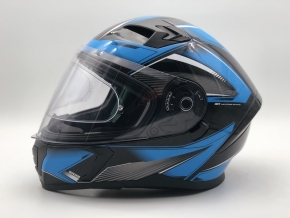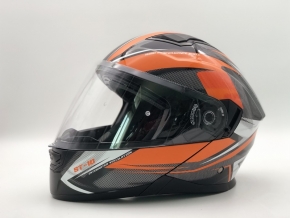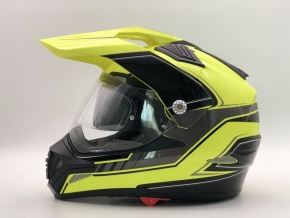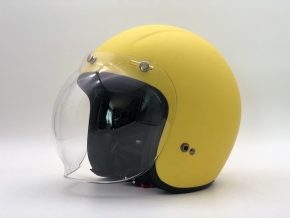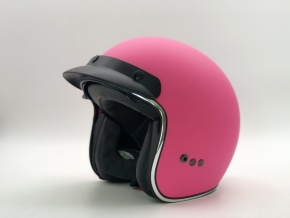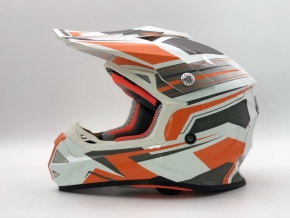Electric vehicle helmet manufactor Helmets are divided into Class A helmets and Class B helmets according to the different use objects. Class A helmets are equivalent to motorcycle helmets with a total emissions of more than 125cc, and have two shapes: full helmet and half helmet; Class B helmets are applicable to motorcycle helmets with a total displacement of less than 125cc. Their volume and weight are smaller than those of Class A helmets, and their shapes are basically half helmets. Therefore, electric vehicle helmets are mainly of Class B.
According to different materials, there are many kinds of materials, such as ABS, PC, FRP, etc. The ordinary helmet is made of polyester ethylene, and the safest helmet is made of carbon fiber.
The helmets made by the manufacturers of electric vehicle helmets are generally divided into shell, buffer layer, inner layer, jaw protection, lace, lens, etc. Among them, the shell is a very important part of the helmet, which is used to withstand and evacuate the impact during impact, so the selection of shell materials is very important; The buffer layer has a cushioning effect when encountering a strong impact. It is usually made of materials that can absorb collision energy, are non-toxic, harmless, sweat absorbing and breathable. The large surface buffer layer is made of foamed styrene (EPS) material.
Factors affecting the safety protection performance of helmets mainly include:
Protective area of helmet
Position stability of helmet
Bearing capacity of the strap system
Protection against impact and puncture
The shell is the first line of defense to protect the head of electric vehicle helmets when they receive impact, withstand and evacuate impact, so the shell material of helmets is the most important. Commonly used housing materials mainly include ABS, PC/ABS, PC, glass fiber reinforced materials, carbon fiber composite materials, etc.
1. ABS resin
ABS resin is a thermoplastic polymer material with high strength, good toughness, strong impact resistance, good dimensional stability, and easy processing and molding. It has excellent comprehensive performance and wide applications. At present, helmets made of ABS are very common on the market. They are light in weight, high in strength, strong in resistance to falling, and have good comprehensive protection performance.
2. Polycarbonate
Polycarbonate is an amorphous, odorless, non-toxic, highly transparent colorless or yellowish thermoplastic engineering plastic, which has excellent physical and mechanical properties, especially excellent impact resistance, high tensile strength, bending strength, compression strength, small creep, and dimensional stability. It is often used to make helmets and helmets, protective masks, sunglasses and sports goggles.
3. PC/ABS plastic
PC/ABS plastic alloy combines the excellent characteristics of the two materials, which not only has the excellent heat resistance and weather resistance, dimensional stability and impact resistance of PC resin, but also has the excellent processing fluidity of ABS resin. At present, alloy materials are widely used in helmets in China.
4. Super tough nylon
Nylon has good toughness, cold resistance and impact resistance. Super tough nylon will have a certain market.
5. Glass fiber reinforced material
Glass fiber reinforced material is a composite material of glass fiber and one or more thermosetting or thermoplastic resins, which has many advantages such as light weight, high strength, anti-corrosion, heat preservation, insulation, sound insulation, etc. This new composite material is lighter and stronger than ABS, but it is also more difficult to make, and its output is lower, so it is more expensive than ABS.
6. Carbon fibre
Carbon fiber is a high strength and high modulus fiber with more than 90% carbon content, and its high temperature resistance ranks first among all chemical fibers. It is made of acrylic fiber and viscose fiber through high-temperature oxidation and carbonization, and is an excellent material for manufacturing high-tech equipment such as aerospace. In short, carbon fiber is very strong, light, high technology content, but also very expensive.
With the implementation of the security action of "One Helmet One Belt", the manufacturers of electric vehicle helmets are also experiencing growth, and material enterprises, processing enterprises, equipment enterprises and related industrial chain enterprises will all benefit.
Compared with motorcycle helmets, bicycle helmets, roller skating helmets and other helmet products, there are corresponding national standards, and each indicator has strict standards. At present, electric vehicle helmets are in this area or blank, so there is no corresponding basis for relevant testing, and it is impossible to standardize the production of electric vehicle helmets.
However, a few days ago, the Zhejiang Yueqing Helmet Industry Association, which has a large number of manufacturers of electric bicycle helmets, formulated the Group Standard for Electric Bicycle Passenger Helmets, which stipulates the standards for helmets composed of shells, buffer layers, wearing devices, etc. The tough and durable cut new ABS materials are used, and the helmet mass (including accessories) is not more than 800g and other standard specifications.
